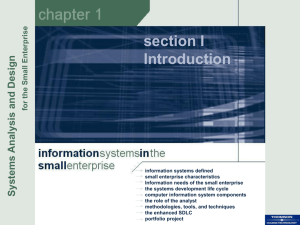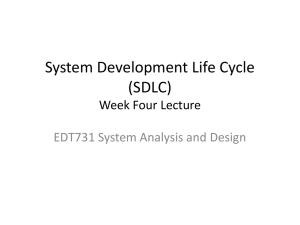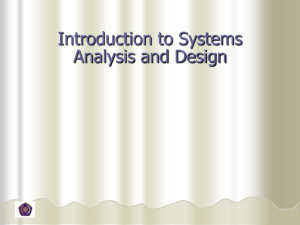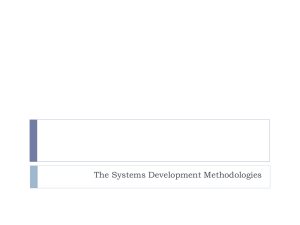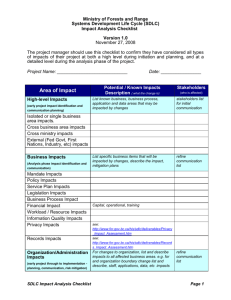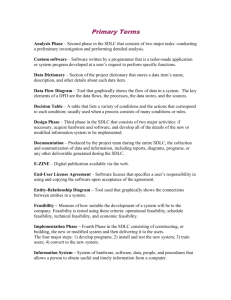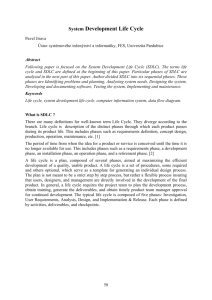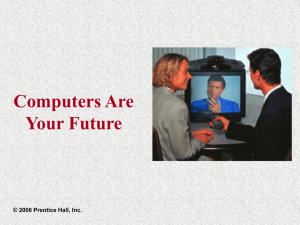Chapter
advertisement
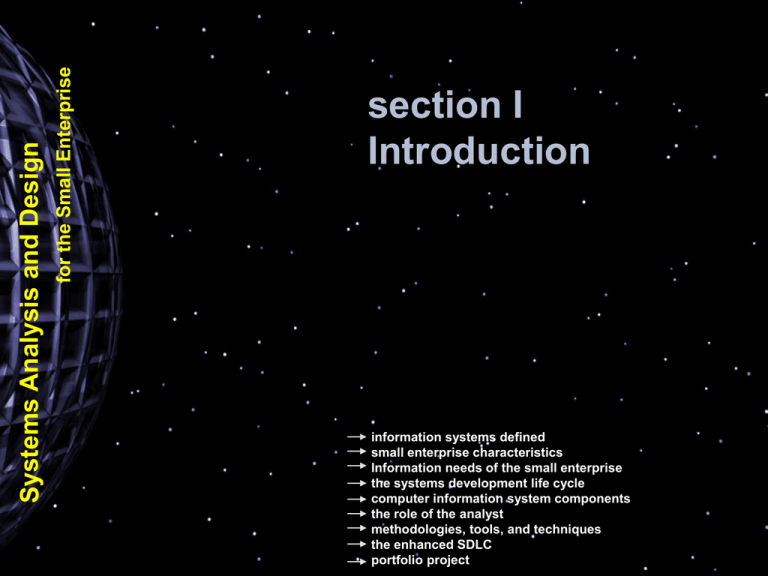
for the Small Enterprise Systems Analysis and Design section I Introduction information systems defined small enterprise characteristics Information needs of the small enterprise the systems development life cycle computer information system components the role of the analyst methodologies, tools, and techniques the enhanced SDLC portfolio project Systems definition • a set of entities, real or abstract, comprising a whole where each component interacts with or is related to at least one other component. • Any object which has no relation with any other element of the system is not part of that system but rather of the system environment. • A subsystem then is a set of elements, which is a system itself, and a part of the whole system. • In other words . . . Systems definition • A system is composed of regularly interacting or interrelating groups of activities/parts which, when taken together, form a new whole. In most cases this whole has properties which cannot be found in the constituent elements.. . . Systems definition example Systems definition example Car as a System • Car – Propulsion (engine) • Fuel • Electrical – Comfort • Temperature • Entertainment – Radio – TV / Video – Control • Braking • Steering • Acceleration – Signal – Safety • Starting • Seatbelts • Air bags – Monitoring • • • • Speedometer Odometer Temperature Oil The concept of a system 6 How do the “rules” change 7 How do the “rules” change 8 Systems definition example System: An interrelated set of components, with an identifiable boundary, working together for some purpose General System Depiction Environment: Everything external to a system that interacts with the system. General System Depiction Boundary: The line that marks the inside and outside of a system and that sets off the system from its environment. General System Depiction Components: An irreducible part or aggregation of parts that make up a system, also called a subsystem.. General System Depiction Interrelationship: Dependence of one subsystem on one or more subsystems. General System Depiction Input: Whatever a system takes from its environment in order to fulfill its purpose. General System Depiction Output: Whatever a system returns to its environment in order to fulfill its purpose. General System Depiction Interfaces: Point of contact where a system meets its environment or where subsystems meet each other. Information Systems Defined • An information system is a well-coordinated collection of resources that gather and transform data into information products and services that help the enterprise perform its designed functions • An information system hierarchy associates different classifications of information systems with different audiences 17 Information System Hierarchy 18 Information Systems Defined Three significant trends influence the evolution of information systems and provide opportunities for the entrepreneurial systems analyst: • The emergence of small enterprise computing • The Internet as a dominating technology • The maturation of application software 19 Small Enterprise Characteristics The following small enterprise characteristics influence the analyst’s work: • Owner participation • Economic constraints • Competitive pressures 20 Information Needs of the Small Enterprise The following are common information needs of any enterprise: • • • • • Production and inventory Personnel Financial reporting Marketing, sales, and service Customer relations 21 TECHNOTE 1-1 Computing Terminology Several software products are integral to the analyst’s work: •Off-the shelf application software •Software suites •Computer assisted systems engineering (CASE) •Object-oriented application software 22 The Systems Development Life Cycle The systems development life cycle (SDLC) consists of five major phases: • • • • • Analysis Design Development Implementation Maintenance 23 The Circular SDLC 24 The Recurring SDLC 25 Information System Components There are six major information system components: • • • • • • People Procedures Software Hardware Networks Data Reference Figure 1-7: Information System Components 26 TECHNOTE 1-2 Software Classifications System Software •Operating systems •Firmware •Utility Application Software •Horizontal •Vertical •Turnkey Customizable Software •Third-generation programming languages •Fourth-generation programming language (4GL) •Object-oriented programming language •4GL products 27 The Role of the Analyst • An agent of change • A problem-solving strategist • A group facilitator • Four Sets of Analytical Skills – – – – Systems Thinking Organizational Knowledge Problem Identification Problem Analyzing and Solving 28 The Blurred Proportional SDLC 29 Methodologies, Tools, and Techniques • CASE Tools • Systems Architect • Alternatives to CASE technologies (VISIO) 30 The Enhanced SDLC The enhanced SDLC embodies several important concepts: • • • • The recurring nature of the SDLC The blending of several phases of the SDLC The influence of the user throughout the SDLC The addition of many powerful tools to assist the analyst 31 The Enhanced SDLC 32 Chapter Summary (1/3) • Small enterprise, PC-based computing should rely on proven systems theory and techniques • The small enterprise approach presents special advantages for an introductory study of systems analysis • The systems development life cycle provides a framework for creating a small enterprise information system 33 Chapter Summary (2/3) • There are five phases of the SDLC: • • • • • Analysis Design Development Implementation Maintenance • There are six components of an information system • • • • • • People Procedures Software Hardware Networks Data 34 Chapter Summary (3/3) • A systems analyst is: – An agent of change – A problem solving strategist – A group facilitator • Characteristics of a System – – – – – – – – – Components Interrelated Components Boundary Purpose Environment Interfaces Input Output Constraints 35


